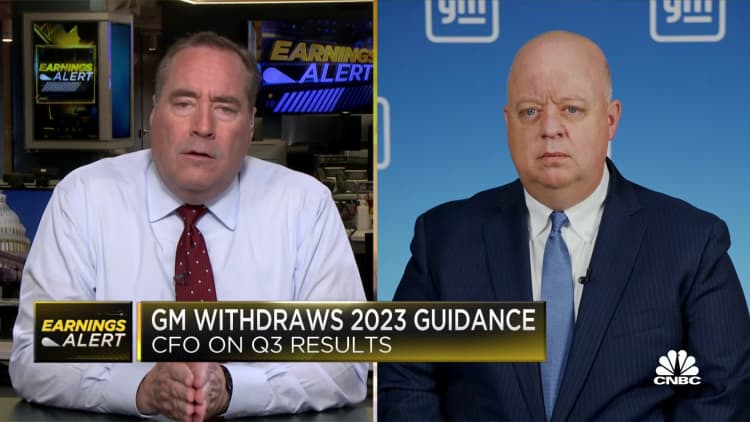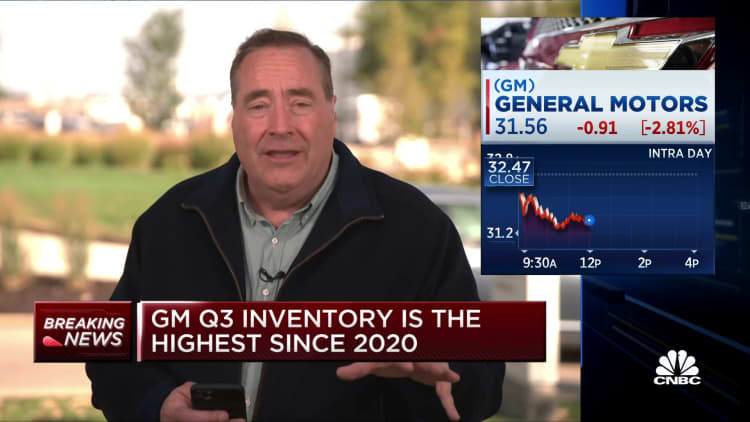GM tops Q3 expectations but pulls full-year guidance due to mounting UAW strike costs

DETROIT — General Motors beat Wall Street’s third-quarter expectations on Tuesday, as it battles through ongoing labor strikes by the United Auto Workers union that’s costing the automaker roughly $200 million a week in lost vehicle production.
The labor strikes, which started Sept. 15, have cost the automaker roughly $800 million in pretax earnings due to lost vehicle production, including $200 million during the third quarter, CFO Paul Jacobson told reporters during a briefing,
The UAW dealt another blow to GM just hours after its quarterly reporting, expanding its strikes to a highly profitable GM plant.
Due to the ongoing volatility caused by the strikes, GM said Tuesday it is pulling its previously announced earnings guidance for the year that called for $12 billion to $14 billion in adjusted earnings and net income attributable to stockholders of between $9.3 billion and $10.7 billion.
Before the UAW strikes, Jacobson said the company was on track to achieve “toward the upper half” of its earnings forecast.
Here’s how the company performed in the third quarter, compared with average estimates compiled by LSEG, formerly known as Refinitiv:
- Adjusted earnings per share: $2.28 versus $1.88, estimated
- Revenue: $44.13 billion versus $43.68 billion, estimated
GM’s stock bounced around following the report, at one point hitting a new 52-week low of $28.01 per share. The stock closed Tuesday at $28.56, down by 2.3%.
For the third quarter, GM reported net income attributable to stockholders of $3.06 billion, or $2.20 per share, down 7.3% from a year earlier when the company earned $3.31 billion, or $2.25 per share.
Revenue during the period increased 5.4% from $41.89 billion a year earlier, while adjusted earnings before interest and taxes (EBIT) declined 16.9% from the third quarter of 2022 to $3.56 billion.
GM’s North American adjusted earnings were off 9.5% during the third quarter from a year earlier to $3.53 billion. Its international operations increased earnings by roughly 7% to $357 million, while its equity income from operations in China were down year over year by about 42% to $192 million.
GM said Tuesday that from January to September of this year it lost roughly $1.9 billion on Cruise, the company’s majority-owned autonomous vehicle subsidiary. Those losses include $732 million during the third quarter, as the company geographically expands operations.
EVs
Jacobson said GM also is pulling near-term targets for its electric vehicles amid slower-than-expected demand. The automaker had previously set goals to sell 400,000 EVs in North America from 2022 through mid-2024 and produce 100,000 EVs in North America during the second half of this year.
Jacobson said GM will retain its targets of achieving low-digit profit margins on EVs as well as North American annual production capacity for the vehicles of 1 million by 2025.

“We’re really focusing on making sure that we’re driving toward demand targets,” Jacobson said. “We’re balancing production to demand.”
GM last week said it would delay production of electric trucks at a second plant in Michigan by at least a year until late 2025. The delay is expected to save GM about $1.5 billion in capital next year, Jacobson said.
GM CEO Mary Barra said Tuesday the company is also delaying production by several months of the Equinox EV, Silverado EV RST and GMC Sierra Denali EV.
GM continues to increase output of the EV models that are currently in production as well as battery cell production at a joint-venture plant with LG Energy Solution in Ohio, according to Jacobson.
He said the automaker is seeing improvement in earlier problems in battery cell production that hampered EV output, however officials are still “working through the issues.”
A second battery cell plant in Tennessee is expected to begin production early next year. Two other similar U.S. plants also are planned for the automaker through 2026, Barra reconfirmed Tuesday.
Overall, Jacobson said GM is focused on “streamlining the business” wherever it can to reduce costs and boost profits to achieve 2025 financial targets.
Barra, in a letter to shareholders, said through next year the company will launch “a wide range of new SUVs that are more profitable than the outgoing models.”
UAW
GM has been navigating ongoing strikes by the UAW after the union and Detroit automakers failed to reach tentative labor deals by a Sept. 14 deadline for contracts covering 146,000 union workers.
The UAW has been expanding work stoppages at GM, Ford Motor and Stellantis as bargaining continues.
Shortly after GM’s earnings call concluded Tuesday morning, the UAW announced a new strike at GM’s highly profitable SUV plant in Arlington, Texas. That factory, which builds the large Chevrolet Tahoe and Suburban, GMC Yukon, and Cadillac Escalade SUVs, employs about 5,000 hourly workers.
“Another record quarter, another record year. As we’ve said for months: record profits equal record contracts.” said UAW President Shawn Fain in a statement announcing the latest strike. “It’s time GM workers, and the whole working class, get their fair share.”
As of Monday, more than 40,000 UAW members at the automakers, or roughly 28% of UAW members covered by the expired contracts, were on strike. The Arlington strike will add about 5,000 striking UAW members to that total.
GM now has about 14,000 UAW-represented workers on strike. Another 2,350 or so GM employees have been laid off at other operations due to the strikes as of early Tuesday, according to the company.
United Auto Workers President Shawn Fain during an online broadcast updating union members on negotiations with the Detroit automakers on Oct. 6, 2023.
Screenshot
The UAW, which had recently escalated its efforts by striking pickup truck plants at Ford and Stellantis, hadn’t expanded its strikes at GM since Sept. 29.
During the last round of contract bargaining four years ago, a national 40-day UAW strike against GM cost the company about $3.6 billion in earnings that year.
During the earnings call, Jacobson had declined to estimate how much the impact of the strikes would increase if expanded to other plants such as Arlington, which the union had previously threatened as a potential target.
“We’re trying to prepare the best we can to whatever decisions they might make, but we remain optimistic and hopeful that we’ll make progress and get this resolved going forward,” he said.
Article Courtesy of CNBC
